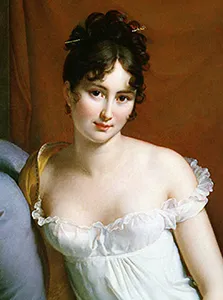Mary Cecelia Rogers was a young lady who captivated those with whom she came into contact. She rose to prominence amidst the bustling streets of New York City during the early 1840s.
Mary’s narrative began in her mother’s boarding and lodging house situated on Nassau Street. Growing up, she assisted her mother in the management. As she blossomed into a resplendent young woman, her irresistible presence caught the attention of John Anderson, a well-known purveyor of cigar dealer.
Intrigued by Mary’s elegance and beauty, Anderson devised a scheme to employ her both as a clerk and an attraction in his thriving emporium. Mary’s mother initially hesitant due to concerns regarding certain visitors to the store. Then she eventually consented, swayed by the generous offer and Mary’s persuasive entreaties.
The cigar store soon witnessed a surge in clientele as Mary’s presence drew admirers. Her demeanor was exemplary as she warmly greeted visitors with a smile while skillfully rebuffing unwelcome advances.
For a period of ten months, Mary thrived in her role at the store until the fateful day in late January 1841 when she failed to report for work. The sudden absence of Mary perplexed Anderson. Her distressed mother feared the worst. The authorities were notified. The media sensationalized the enigmatic vanishing of the “cigar girl”.
Six agonizing days later, Mary returned to the store. But her once-cheerful countenance had transformed into melancholy and contemplation. Inquiries about her absence met with curt explanations of visiting relatives in the countryside. A subject that Mary, her mother, and Anderson seemed reluctant to broach.
Whispers began to circulate that Mary had been seen in the company of a tall, handsome naval officer during her disappearance. Faced with mounting rumors, Mary abruptly resigned from her position. She sought solace within the confines of her mother’s abode.
A month later, an announcement resounded throughout the community. Mary was betrothed to Daniel Payne, a young clerk residing in her mother’s dwelling. Joy intertwined with apprehension as the couple eagerly anticipated their shared future.
On a fateful Sunday morning in July 1841, Mary rapped on Daniel’s door. She apprised him of her plan to spend the day with her aunt, Mrs. Downing, in Bleecker Street. Obligingly, Daniel pledged to call for her later that evening. However, as night descended, a tempestuous thunderstorm swept through the city, drenching the streets with torrential rain.
Daniel believed that Mary would prefer to evade the storm. He decided against calling for her and made his way home unaccompanied. He apprised Mrs. Rogers, Mary’s mother, of his decision. She expressed relief. She was grateful that her daughter had not been subjected to the elements.
As the following day dawned, Mrs. Rogers eagerly awaited Mary’s return, yet her daughter failed to materialize. She was consumed when Daniel arrived for dinner. Mrs. Rogers shared her escalating anxiety. Without hesitation, Daniel embarked on a visit to Mrs. Downing, hoping to find answers.
Mrs. Downing revealed that Mary was not there at her residence on the aforementioned day. Daniel realized the gravity of the situation. The second disappearance of Mary Rogers sent shockwaves through the community. Public outcry started against the faltering investigation.
Also visit the previous blog Marcia Edwards Scribbled the Name of her Killer by Fehmeeda Farid Khan
Days turned into weeks without a trace of Mary. The press vehemently criticized the police for their lack of progress. In response, the authorities proffered a substantial reward for information leading to the apprehension and conviction of the perpetrator. They even promised immunity and protection to anyone with knowledge of the crime, except for the actual murderer.
An anonymous missive arrived at the police station. It shed light on Mary’s activities in Hoboken on the day of her disappearance. The letter described witness her accompanied by six rough-looking men who ventured into the nearby woods.
With the newfound lead, investigators descended upon the area mentioned in the letter. Their search yielded pivotal evidence in the form of garments and personal effects belonging to Mary.
Amidst the investigation, another witness emerged, a stage driver named Adams. He recollected seeing Mary in Hoboken with a tall, dark-complexioned gentleman who whisked her away to a roadhouse near the Elysian Fields. A chilling scream pierced the night, sending shivers down the spines of all who heard it.
Despite the mounting clues and community’s unwavering determination for justice, the case of Mary Rogers gradually receded from the headlines. Speculation and theories abounded, including accusations leveled against Mary’s mother, insinuating that she held the key to the enigma but remained silent to safeguard her daughter’s reputation.
The tragic events surrounding disappearing of Mary and murder cast a somber pall over the city. Daniel Payne, the grief-stricken fiancé, was unable to bear the loss. He chose to join Mary in eternal rest by suicide.
Years passed, and the tale of Mary Rogers began to fade from memory until the renowned author Edgar Allan Poe breathed new life into her narrative. Inspired by the unsolved mystery, he penned “The Mystery of Marie Rogêt”. He transplanted the setting to Paris and introduced his detective character, C. Auguste Dupin. He endeavoured to untangle the perplexing circumstances surrounding a fictional rendition of tragic fate of Mary.
The haunting case of Mary Rogers remains etched in history as an enigma that remains unsolved.
 FFK Blog Fehmeeda Farid Khan Blog for Unsolved Miseries
FFK Blog Fehmeeda Farid Khan Blog for Unsolved Miseries

